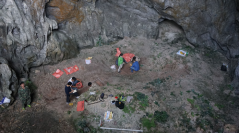

 Comptes Rendus Palevol
22 (5) - Pages 59-76
Comptes Rendus Palevol
22 (5) - Pages 59-76This paper presents a case study from the Hiem cave (Hoà Bình province, North Vietnam) showing how a multidisciplinary approach in archaeological research can develop knowledge on the everyday life of the hunter-gatherer Hoabinhian groups occupying the cave during the early Holocene (8500-8200 cal BC). The archaeological analysis presents the characteristic Hoabinhian artefacts and their usage, while archeozoological, malacological and archaeobotanical research throw light on the way of life, including plant and animal elements of a daily diet as well as the settlement seasonality of the cave.
Lithic technology, animal remains, plant remains.